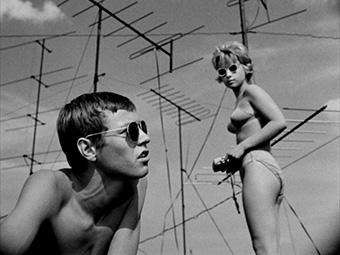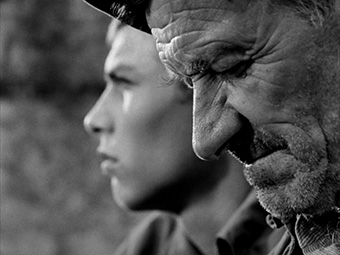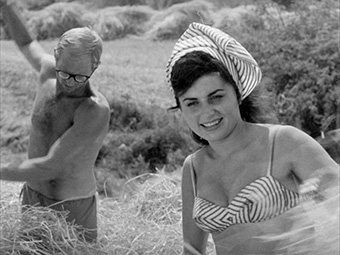|
Faced with the prospect of reviewing a film that is credited to have helped launched the 1960s Czech New Wave, I found myself stricken by a curious blend of eager anticipation and hesitant dread. It's not that I disliked what I've so far seen of Czech New Wave cinema. Far from it. Juraj Herz's 1969 The Cremator [Spalovac mrtvol] was one of the most cinematically exciting films I warched last year. It's just that my knowledge of 60s Czech cinema is not nearly as extensive as it probably should be and a pale shadow of that of my former writing colleague L.K. Weston, who quickly became the default reviewer of any such titles that came our way. And the Czech New Wave is one of the sacred cows of so-called serious film criticism, written about and analysed in imposing detail by learned cineastes who tend to cut newcomers and dissenters precious little slack.

So it was with more than a whisper of apprehension that I popped Štefan Uher's intriguingly titled The Sun in a Net [Slnko v sieti] into my player. I knew nothing of the director or the film in question, save for its imposing status as a little seen but important film movement launcher. My uncertainty was not eased by an opening montage of seemingly disconnected monochrome images that gave little opportunity to meaningfully connect with or ascribe meaning to: an old shack located on the bank of a mist-shrouded river; a bustling metropolitan street; a young man listening to a transistor radio on a tower block rooftop; a game in which child walks a hopscotch grid with her eyes closed and a small piece of broken glass balanced on the back of her outstretched hand; an old man wandering through a housing estate archway; kids climbing on dustbins to expose their faces to sunlight. The first conversation offers little help, an exchange in which the participants appear to be talking independently without directly responding to or even acknowledging the words of the other. But stick with it and everything eventually makes sense and interconnects, much of it on a symbolic as well as narrative and character level.
The boy on the rooftop is Fayolo (Marián Bielik), and the girl with whom he is having a dissociative conversation is his 15-year-old girlfriend Bela (Jana Beláková), and the two appear keen to keep their relationship a secret from Bela's gruff father Jan (Andrej Vandlík) and his blind mother Stanka (Eliška Nosáľová). When Fayolo departs for a summer job on a farming cooperative in Melenany, Bela hangs out with the self-confident Peto (Ľubo Roman), while Fayolo becomes involved with cheerful young worker Jana (Oľga Šalagová). Not much of a storyline you may well think, and were this all there was to it you'd probably be right. But in Uher's confident hands this becomes the skeletal base on which a complex, richly textured and multi-layered body is constructed.
With background details not immediately forthcoming and the motivation for narrative progression sometimes tucked away in the dialogue, it's the social realism and observational element that prove the primary hooks. The film's portrait of casual teen relationships (and let's not forget Bela's age here), disenchanted and even disrespectful youth, and a family whose history includes adultery and attempted suicide may be the stuff of daytime drama now, but must have felt as fresh and revolutionary in 1962 Czechoslovakia as the early works of the French Novelle Vague or the Italian neo-realists did on their home turf.

Less immediately evident but more problematic for the film in its day are a number of sly political digs, most visible during Fayolo's spell at the farming collective, where machinery cannot be repaired due to a shortage of wood, which the workers would be able to take from the nearby forest were the tress there not all the property of the state. It's here that Fayolo learns the value of silence, as the pop music that was once his constant companion becomes a state-sponsored disruption of countryside calm, blared from a publicly situated speaker that Fayolo helps Bela's ear-battered grandfather Blažej to disable. It's an action echoed elsewhere by the switching off of noisy transistor radios by Jana and the fisherman whom Fayolo has befriended, but whose pontoon is unceremoniously commandeered for sunbathing by the cocksure Peto, the film's symbol of directionless youthful rebellion. It's also not a stretch to read Fayolo's photographic fascination with hands as a commentary on the key role played by manual labour in a utilitarian society, and his late film decision to post his facial portrait of Blažej smack in the middle of a window of these pictures thus plays as a call to appreciate the person rather than their role in the workforce. Such subtle digs certainly got up the nose of the then censorial Slovakian authorities, who promptly banned the film for its alleged use of 'coded messages'.
Even more enthralling is the complex substructure that increases in density as the film progresses, as an action or image in a later scene triggers the memory of an earlier, seemingly throwaway moment that now can be seen to have had specific purpose. This is especially true of Stanka's blindness (which itself may have a metaphorical role), which is prefigured both physically in the eyes-closed game being played by the children in the opening montage, and cinematically through the method of Stanka's introduction, a slow track up to the back of her head in which her eyes are kept hidden, which is followed immediately by the image of her husband checking his reflection in a mirror. This is carried through in darkening effect of the impending solar eclipse and the smoking of glass to provide a form of artificial visual impairment through which the event can be safely observed, and yet again in shots filmed as murky and unstable reflections in water, in a portrait on Fayolo's wall of a man with eyes covered by the hands of another, and even in the presence of Fayolo's parents as voice-only characters, as invisible to us as Stanka's family are to her. Elsewhere, the meaning of an image can alter with time, as with the ant that Fayolo watches pulling a twig that is considerably longer than its body, a seemingly symbolic representation of his own toil that is more specifically echoed later by the image of him and two comrades carrying a large stolen tree which, in a neat bit of metaphorical circle-closing, will be used to repair machinery to aid with their toil. And believe me, I'm just skimming the surface here and have not even touched on the meaningful locational cross-cutting of Bedřich Voděrka's editing.

All of this may smack of reading meaning into imagery and actions that were never designed to be so interpreted, but the connections are too precise and too numerous to be credited solely to chance. And every frame of the film has clearly been composed and dressed with purpose beyond the more straightforward desire to be pleasing to the eye, and please the eye it most definitely does. Stanislav Szomolányi's monochrome cinematography is consistently gorgeous and rich in suggestion, dwarfing Fayolo and Bela in an astonishing forest of gargantuan TV aerials, lighting and framing the energetically enthusiastic farmworkers in the manner of a Soviet propaganda short, and closing in tellingly on the hands and the faces that so fascinate Fayolo's own photographic eye. The use of sound is equally striking, from the pop music chatter of transistor radios and the apartment block's strangely musical elevator to the between-station static and Ilja Zeljenka's sparely used but unsettling avant-garde score, with Forbidden Planet-esque electronic tonalities are employed to imbue the eclipse itself with a sense of almost apocalyptic foreboding.
The cumulative effect of this approach, coupled with enough acutely observed character detail to warrant its own essay, prompts a more fully formed engagement with the characters and their situation than Fayolo and Bela's early rooftop encounter could ever have suggested, one that engages the emotions as well as thrilling the intellect. My initial trepidation was clearly unwarranted, as detailed knowledge of the Czech New Wave and the work of Štefan Uher is not required – everything you need to appreciate this genuinely remarkable film is up there on screen.
I'm getting used to the transfers on Second Run discs being of the highest order, but their sheer quality still manages to catch me by surprise. The Sun in a Net is no exception, a crisp, tonally seductive 1.33:1 transfer that handsomely showcases the film's consistently fabulous monochrome imagery. The contrast is punchy and the black levels solid – on some exterior shots this does seem to pull in some of the darker detail, but still looks right for the brightly sunlit imagery. There is some faint flickering to the image at times, but this is never distracting. The detail on close-ups is excellent for a DVD transfer. There's clearly life in standard definition yet.

The Dolby 2.0 mono soundtrack captures the dialogue and sound effects clearly and betrays no trace of wear or damage. The range restrictions and treble bias are par for the course for a film of its place and time.
An Appreciation by Peter Strickland (11:37)
The director of Berberian Sound Studio reveals how he first encountered the film and quietly enthuses about just what makes it so special for him, specifically highlighting Stanislav Szomolányi's cinematography (he states at one point that he could watch the film repeatedly just for its imagery). I was personally chuffed that he singled out The Cremator as a personal favourite. It looks very much like Strickland filmed the interview himself – I was a little surprised to see a cameraman credited at the end.
Also included is a Booklet containing a detailed essay and very worthwhile on the film, the director and Slovak cinema in general by Peter Hames. Also included are credits for the film and some quality stills.
Another terrific rediscovery by Second Run, handsomely presented and with a nicely targeted pair of extra features. Blending social realism with cinematic poetry, The Sun in a Net is a must-see for anyone with even a passing interest in the Czech New Wave or, I would suggest, world cinema in general. Highly recommended.
|